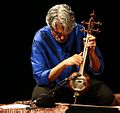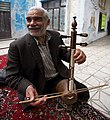 Persian Kamānches, ca. 1880 Persian Kamānches, ca. 1880 | |
| String instrument | |
|---|---|
| Other names | Kamancha, Kamanche, Kemancheh, Kamanjah, Kabak kemane |
| Classification | Bowed strings |
| Developed | Iran |
| Playing range | |
| g3-e7 | |
| Related instruments | |
| Musicians | |
| Builders | |
| Sound sample | |
| Kamancheh music Kamancheh Improvisation Played by Kayhan Kalhor – Silk Road Project | |
| Art of crafting and playing with Kamantcheh/Kamancha, a bowed string musical instrument | |
|---|---|
| UNESCO Intangible Cultural Heritage | |
| Country | Azerbaijan and Iran |
| Reference | 01286 |
| Inscription history | |
| Inscription | 2017 (13th session) |
| List | Representative |

The kamancheh (also kamānche or kamāncha) (Persian: کمانچه, Azerbaijani: kamança, Armenian: քամանչա, Kurdish: کەمانچە ,kemançe) is an Iranian bowed string instrument used in Persian, Azerbaijani, Armenian, Kurdish, Georgian, Turkmen, and Uzbek music with slight variations in the structure of the instrument.
The kamancheh is related to the rebab which is the historical ancestor of the kamancheh and the bowed Byzantine lyra. The strings are played with a variable-tension bow.
In 2017, the art of crafting and playing with Kamantcheh/Kamancha was included into the UNESCO Intangible Cultural Heritage Lists of Azerbaijan and Iran.
Name and etymology
The word "kamancheh" means "little bow" in Persian (kæman, bow, and -cheh, diminutive). The Turkish word kemençe is borrowed from Persian, with the pronunciation adapted to Turkish phonology.
It also denotes a bowed string instrument, but the Turkish version differs significantly in structure and sound from the Persian kamancheh.
There is also an instrument called kabak kemane literally "pumpkin-shaped bow instrument" used in Turkish music which is only slightly different from the Iranian kamancheh.
Structure
The kamancheh has a long neck including fingerboard which kamancheh maker shapes it as a truncated inverse cone for easy bow moving in down section, pegbox in both side of which four pegs are placed, and finial Traditionally kamanchehs had three silk strings, but modern instruments have four metal strings.
Kamanchehs may have highly ornate inlays and elaborately carved ivory tuning pegs.
The body has a long upper neck and a lower bowl-shaped resonating chamber made from a gourd or wood, usually covered with a membrane made from the skin of a lamb, goat or sometimes a fish, on which the bridge is set.
From the bottom protrudes a spike to support the kamancheh while it is being played, hence in English, the instrument is sometimes called the spiked fiddle.
It is played sitting down held like a cello though it is about the length of a viol. The end-pin can rest on the knee or thigh while the player is seated in a chair.
Kamancheh is usually tuned like an ordinary violin (G, D, A, E).
-
 Kamancha on the Armenian miniature, XVI or XVII century.
Kamancha on the Armenian miniature, XVI or XVII century.
-
 Qajar Iran miniature of a woman playing the kamancheh.
Qajar Iran miniature of a woman playing the kamancheh.
-
 A woman playing the kamancheh. Detail from a wall painting in which Mohammad Ali Shah Qajar is surrounded by musicians and dancers. Painted by Abuʾl-Qasim, dated 1816.
A woman playing the kamancheh. Detail from a wall painting in which Mohammad Ali Shah Qajar is surrounded by musicians and dancers. Painted by Abuʾl-Qasim, dated 1816.
-
 Woman playing kamancheh, ca. 1820.
Woman playing kamancheh, ca. 1820.
-
 The Armenian ashugh Sayat-Nova playing a kamanacheh, ca. 1964.
The Armenian ashugh Sayat-Nova playing a kamanacheh, ca. 1964.
-
 Azerbaijani kamancheh player Malik Mansurov.
Azerbaijani kamancheh player Malik Mansurov.
-
 Kayhan Kalhor performance in Vahdat Hall, Tehran, 2016.
Kayhan Kalhor performance in Vahdat Hall, Tehran, 2016.
-
 Kamancheh player, Kermanshah, Iran, 2008.
Kamancheh player, Kermanshah, Iran, 2008.
-
 Kamancha player, Yerevan.
Kamancha player, Yerevan.
Notable kamancheh players
- Habil Aliyev
- Mehdi Bagheri
- Ali-Asghar Bahari
- Mark Eliyahu
- Kayhan Kalhor
- Ardeshir Kamkar
- Kourosh Babaei
- Sayat-Nova
- Mostafa Taleb
- Yaara Beeri
- Mehrnam Rastegari
See also
- List of bowed stringed instruments
- Music of Armenia
- Music of Iran
- Music of Azerbaijan
- Byzantine lira
- Haegeum
- Rebab
- Silk Road Ensemble
References
- Global Minstrels: Voices of World Music. Elijah Wald. 2012. p. 227. ISBN 9781135863685.
- "Kamancha". UNESCO.
In the Republic of Azerbaijan it constitutes a major element of classical and folkloric music, and performances occupy a central place in a wide number of social and cultural gatherings.
- Dowsett, Charles (1997). Sayatʻ-Nova: an 18th-century troubadour: a biographical and literary study. Leuven: Peeters Publishers. p. 4. ISBN 90-6831-795-4.
- "Iranian Kurdish musician wins prestigious award". Kurdistan24. 19 August 2019. Retrieved 24 March 2020.
- "Pastimes of Central Asians. Musicians. A Man Practising the Kamancha, a Long-necked Stringed Instrument". World Digital Library. 1865. Retrieved 14 May 2014.
- ^ Martin, Andrew R.; Mihalka, Matthew Ph.D., eds. (2020). Music Around the World: A Global Encyclopedia [3 Volumes]. ABC-CLIO. p. 442. ISBN 9781610694995.
- "Iranian string instrument 'Kamancheh' to be inscribed on UNESCO list". 11 April 2015. Retrieved 1 May 2015.
- "Art of crafting and playing with Kamantcheh/Kamancha, a bowed string musical instrument". UNESCO.
- "کمانچه – پارسی ویکی". loghatnaameh.com. Archived from the original on 2008-10-17.
- "Kabak kemane ve Kemancha hakkında rehber". Archived from the original on 2017-12-14. Retrieved 2014-07-05.
- Chandrakausika, R.A.M. (2013-03-08). "The Masters of Kamanche". A World Heritage Of Native Music. Retrieved 2017-05-16.
- Jonathan M. Bloom, Sheila S. Blair (Ed.): The Grove Encyclopedia of Islamic Art and Architecture. Volume 1. Oxford University Press, Oxford 2009, p. 8
Further reading
- Blum, Stephen (2010). "KAMĀNČA". In Yarshater, Ehsan (ed.). Encyclopædia Iranica. Vol. XV/4: Kafir Kala–Ḵamsa of Jamāli. London and New York: Routledge & Kegan Paul. pp. 434–437. ISBN 978-1-934283-26-4.
- Libin, Laurence, ed. (2014). "Kamāncheh [k'aman, kamanche, kemence] (Pers. 'little bow')". The Grove Dictionary of Musical Instruments (2 ed.). Oxford University Press.
External links
- Nay-Nava: The Encyclopedia of Persian Music Instruments
- Kamanche, Iran, ca. 1869
- Kamanche, Iran, ca. 1880
| Iranian musical instruments | |||||||||
|---|---|---|---|---|---|---|---|---|---|
| Stringed (Sāzhāy-e Zehī) |
| ||||||||
| Woodwind (Sāzhāy-e Bādī) |
| ||||||||
| Brass |
| ||||||||
| Percussion (Sāzhāy-e Kūbeheyī/Zarbī) |
| ||||||||
| Afghan traditional music Azerbaijani traditional music Kurdish traditional music Persian traditional music Tajik traditional music | |||||||||
| Armenian musical instruments | |
|---|---|
| Percussion instruments | |
| Wind instruments | |
| String instruments | |
| See also | |
| Azerbaijani musical instruments | |
|---|---|
| String instruments | |
| Woodwind instruments | |
| Percussion instruments |
|
| Possibly extinct | |
| See also | |
| Turkish musical instruments | |
|---|---|
| String instruments |
|
| Woodwind instruments | |
| Percussion instruments | |
| See also | |
| UNESCO Intangible Cultural Heritage elements in Iran | |
|---|---|
| Inscribed in 2009 | |
| Inscribed in 2010 | |
| Inscribed in 2011 | |
| Inscribed in 2012 | |
| Inscribed in 2016 |
|
| Inscribed in 2017 |
|
| Inscribed in 2019 |
|
| UNESCO Intangible Cultural Heritage elements in Azerbaijan | |
|---|---|
| |
| Shared |
|
| Need of Urgent Safeguarding |
|